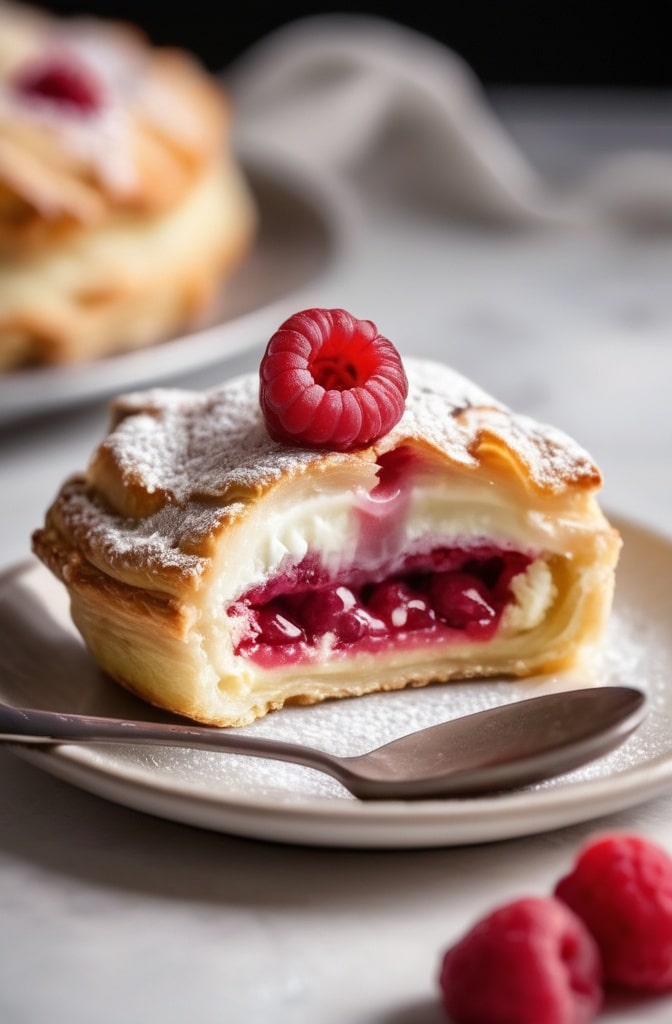There’s something magical about the moment when your teeth first pierce through a perfectly flaky Raspberry Almond Pastry. That delicate crunch giving way to a luscious filling is what I live for as a pastry chef. I’ve spent years perfecting this Raspberry Almond Pastry recipe, and lemme tell you it’s become the most requested item at family gatherings and professional events alike.
This isn’t just any pastry. It’s a harmonious marriage of buttery layers, tangy raspberry, and rich almond cream that transforms ordinary ingredients into something extraordinary. What makes it special is the technique of lamination combined with the balance of tart raspberries against the sweet almond filling a combination that’s both timeless and surprisingly uncommon in home baking.
Ingredients & Substitutions
For the Pastry Dough:
- 3½ cups all-purpose flour (430g)
- 1 teaspoon fine sea salt
- 1 tablespoon granulated sugar
- 1½ cups cold unsalted butter (340g), cut into ½-inch cubes
- ⅔ cup ice water (160ml), plus more if needed
- 1 tablespoon fresh lemon juice
For the Almond Cream Filling:
- 1 cup almond flour (100g)
- ½ cup granulated sugar (100g)
- ¼ teaspoon salt
- ½ cup unsalted butter (113g), softened
- 2 large eggs, room temperature
- 1 teaspoon almond extract
- 2 tablespoons all-purpose flour
- 1 teaspoon vanilla extract
For the Raspberry Filling:
- 3 cups fresh raspberries (about 340g)
- ¼ cup granulated sugar (50g)
- 2 tablespoons cornstarch
- 1 tablespoon lemon juice
- 1 teaspoon lemon zest
For Assembly:
- 1 egg, beaten (for egg wash)
- 3 tablespoons sliced almonds
- 2 tablespoons demerara sugar (or coarse sugar)
- Powdered sugar, for dusting
If you’re unable to find fresh raspberries, frozen works wonderfully—just thaw and drain excess moisture. For those with nut allergies, substitute almond flour with sunflower seed flour and almond extract with vanilla bean paste. European-style butter (higher butterfat content) will yield an even flakier texture then regular butter, but either will work beautifully.
Step-by-Step Instructions

Preparing the Pastry Dough:
- Combine flour, salt, and sugar in a large bowl. Whisk them together to ensure even distribution of the salt and sugar.
- Add the cold butter cubes to the flour mixture. Using your fingertips or a pastry cutter, work quickly to incorporate the butter until the mixture resembles coarse crumbs with some larger butter pieces remaining—about the size of peas. Don’t overmix; those butter chunks are crucial for flakiness!
- Mix ice water with lemon juice and drizzle over the flour-butter mixture while stirring with a fork. The dough should just barely come together when pinched between your fingers. Add additional ice water, one tablespoon at a time, if necessary.
- Turn the dough onto a lightly floured surface and form into a rough rectangle. Fold it in thirds like a business letter, then rotate 90 degrees and repeat the folding. This creates the first layers of your laminated dough.
- Wrap the dough tightly in plastic wrap and refrigerate for at least 2 hours, preferably overnight. This rest period allows the gluten to relax and the butter to firm up, which is essential for achieving those beautiful flaky layers.
The most common mistake at this stage is overworking the dough, which develops too much gluten and results in a tough pastry. Keep your touch light and your ingredients cold—I even chill my flour and bowl beforehand during summar months!
Making the Almond Cream Filling:
- In a stand mixer fitted with the paddle attachment, cream together softened butter and sugar until light and fluffy, about 3-4 minutes. Don’t rush this step; proper aeration makes a huge difference in the texture.
- Add almond flour and salt, mixing until well combined. Then add eggs one at a time, ensuring each is fully incorporated before adding the next.
- Mix in the almond extract, vanilla extract, and all-purpose flour until just combined. Transfer to a container and refrigerate for at least 1 hour to firm up.
For a variation with extra depth, try toasting your almond flour in a dry skillet before using it—the nutty aroma it develops is absolutely worth those extra few minutes.
Preparing the Raspberry Filling:
- In a medium saucepan, combine raspberries, sugar, cornstarch, lemon juice, and zest. Mash about half the berries with a potato masher or fork, leaving some whole for texture.
- Cook over medium heat, stirring constantly, until the mixture comes to a simmer and begins to thicken, about 5-7 minutes. You’ll know it’s ready when it coats the back of a spoon.
- Remove from heat and transfer to a bowl. Press plastic wrap directly onto the surface (this prevents a skin from forming) and cool completely in the refrigerator.
If your raspberries are very sweet, you may want to reduce the sugar slightly. On the flipside, if they’re particularly tart, a smidge more sugar might be needed. Trust your taste buds here!
Assembly and Baking:
- Preheat your oven to 375°F (190°C) and line two baking sheets with parchment paper.
- Remove the chilled dough from the refrigerator and divide in half. Return one half to the refrigerator while working with the other.
- On a lightly floured surface, roll the dough into a rectangle approximately 12×16 inches (30×40 cm) and about ⅛-inch thick. Precision matters here—too thick and your pastry won’t bake evenly; too thin and it may tear.
- Transfer the rolled dough to a parchment-lined baking sheet and refrigerate while rolling out the second piece to the same dimensions.
- Remove the first sheet from the refrigerator. Spread the almond cream evenly over the dough, leaving a 1-inch border all around. Then spread the cooled raspberry filling over the almond cream, being careful not to mix the layers too much.
- Brush the exposed border with beaten egg, then carefully drape the second sheet of dough over the fillings. Press the edges firmly to seal, then trim any excess dough to create an even edge. Crimping with a fork creates both a decorative edge and ensures the filling stays put.
- Brush the entire top with beaten egg wash, then sprinkle with sliced almonds and demerara sugar. Cut small vents in the top to allow steam to escape during baking.
- Bake in the preheated oven for 35-40 minutes, rotating the pan halfway through, until the pastry is golden brown and crisp.
- Allow to cool on the baking sheet for 10 minutes, then transfer to a wire rack to cool completely before slicing.
For individual pastries, cut the dough and fillings into smaller rectangles before assembling. The baking time will reduce to about 25-30 minutes, so keep an eye on them!
Cooking Techniques & Science
The magic of this pastry lies in its lamination—a technique where butter is repeatedly folded into dough, creating distinct layers. When heat hits these layers in the oven, the water in the butter converts to steam, pushing the layers apart and creating that irresistible flakiness we all covet. It’s basically the same principle used in croissants, but with fewer folds.
The addition of lemon juice in the dough isn’t just for flavor; the acidity actually inhibits gluten formation, resulting in a more tender pastry. Meanwhile, the cornstarch in the raspberry filling acts as a thickening agent by gelatinizing when heated with liquid, creating that perfect jammy consistency without being runny.

Your kitchen temperature matters enormously for this recipe. On hot days, I’ve been known to turn my AC down to 68°F (20°C) when making laminated doughs. If your kitchen runs warm, you may need extra trips to the refrigerator between rollings to keep the butter from melting into the dough.
Another crucial tool is a good rolling pin—I prefer a French-style pin without handles for better control. And don’t underestimate the value of a straight edge or ruler for measuring your dough; even experienced pastry chefs use them to ensure consistency.
Serving & Pairing Suggestions
This pastry is at its absolute peak the day it’s baked, when the contrast between crisp exterior and tender filling is most pronounced. Serve it slightly warm or at room temperature, dusted with a light snow of powdered sugar just before presenting.
For an elevated brunch, pair slices with mascarpone whipped cream lightly sweetened with honey. The creamy richness compliments the tangy raspberry beautifully. If serving as dessert, a scoop of vanilla bean ice cream or crème fraîche provides a luxurious contrast to the warm pastry.
Beverage pairings are equally important. A bright, acidic coffee like an Ethiopian pour-over cuts through the richness perfectly. For tea enthusiasts, a fragrant Earl Grey or floral jasmine green tea complements the almond notes. And should you be serving this for a special occasion, a glass of Champagne or prosecco turns it into a celebration.
Present this pastry on a wooden board garnished with fresh raspberries and mint leaves for a rustic yet elegant presentation. Or for individual portions, serve on warmed plates with a swirl of raspberry coulis and a sprig of fresh thyme for an unexpected herbaceous note.
Conclusion
This Flaky Raspberry Almond Pastry represents the perfect balance of technique and flavor—approachable enough for dedicated home bakers yet impressive enough for professional settings. The key to success lies in respecting the process: keeping ingredients cold, allowing proper resting time, and handling the dough with a light touch.
What sets this recipe apart is the harmonious interplay of textures and flavors—the buttery crispness of the pastry against the creamy almond filling and bright raspberry center. Its an exercise in contrast and balance that rewards patience and attention to detail.
Remember, pastry-making isn’t just about following instructions; its about developing a feel for the dough and understanding how ingredients behave. Each time you make this recipe, you’ll notice subtle improvements in your technique. That’s the beauty of baking—theres always room to grow and refine.
FAQs About Flaky Raspberry Almond Pastry with Creamy Filling
Can I make this pastry ahead of time?
Yes, but with some caveats. The dough can be prepared and refrigerated up to 3 days in advance or frozen for a month. Both fillings can be made 2 days ahead and kept refrigerated. However, once assembled and baked, the pastry is best consumed within 24 hours, as the moisture from the filling will gradually soften the flaky layers.
Why did my pastry turn out tough instead of flaky?
The most likely culprits are overworking the dough or allowing the butter to warm too much during preparation. Remember to handle the dough minimally, keep everything cold, and give it proper rest periods in the refrigerator. Also, measure your flour accurately—too much flour can lead to a dry, tough result.
How can I tell when the pastry is perfectly baked?
Look for an even, golden-brown color across the surface and a hollow sound when you tap the bottom. If the pastry is browning too quickly but still seems underbaked, tent it loosely with aluminum foil to prevent over-browning while allowing the interior to finish cooking.
Can I use other fruits instead of raspberry?
Absolutely! Blackberries work beautifully with minimal adjustment. For strawberries or peaches, increase the cornstarch to 3 tablespoons as they release more liquid. Tart cherries are another excellent option—just be sure to pit them thoroughly and increase the sugar slightly to balance their acidity.
How do I store leftovers?
Store any leftover pastry loosely covered at room temperature for up to one day. For longer storage (up to 3 days), refrigerate in an airtight container and reheat in a 300°F (150°C) oven for 10 minutes to recrisp the exterior. Freezing is not recommended as it significantly impacts the texture.

